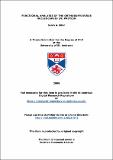Functional analysis of the orthobunyavirus nucleocapsid (N) protein
Abstract
Bunyamwera virus (BUNV) is the prototype of the family Bunyaviridae. It has a
tripartite genome consisting of negative sense RNA segments called large (L),
medium (M) and small (S). The S segment encodes the nucleocapsid protein (N) of
233 amino acids. The N protein encapsidates all three segments to form
transcriptionally active ribonucleoproteins (RNPs). The aim of this project was to
determine the domain map of BUNV N protein.
To investigate residues in BUNV N crucial for its functionality, random and site-
specific mutagenesis were performed on a cDNA clone encoding the BUNV N
protein. In total, 102 single amino acid substitutions were generated in the BUNV N
protein sequence.
All mutant N proteins were used in a BUNV minigenome system to compare their
activity to wt BUNV N. The mutant proteins displayed a wide-range of activity, from
parental-like to essentially inactive. The most disruptive mutations were R94A,
I118N, W134A, Y141C, L177A, K179I and W193A.
Sixty-four clones carrying single substitutions in the BUNV N protein were used in the
BUNV rescue system in an attempt to recover viable mutant viruses. Fifty
recombinant mutant viruses were rescued and 14 N genes were nonrescuable.
The 50 mutant viruses were characterized by: titration, protein labelling, western
blotting, temperature sensitivity and host-restriction. Mutant viruses displayed a wide range of titers between 10³
-10⁸ pfu/ml, and three different plaque sizes large,
medium and small. Protein labelling and western blotting showed that mutations in
the N gene did not affect expression of the other viral genes as much as affecting N
protein expression. It was demonstrated that single amino acid substitutions could
alter N protein electrophoretic mobility in SDS- PAGE (e.g. P19Q and L53F).
Temperature sensitivity tests showed that recombinant viruses N74S, S96S, K228T
and G230R were ts, growing at 33˚C but not at 37˚C or 38˚C, while the parental virus grew at all temperatures. Using the northern blotting technique, mutant viruses N74S
and S96G were shown to have a ts defect in genome-synthesis (late replication
step), while mutant viruses K228T and G230R had a ts defect in antigenome-
synthesis (early replication step).
Host-restriction experiments were performed using 5 different cell lines (Vero-E6,
BHK-21, 2FTGH-V, A549-V and 293-V). Overall, the parental virus grew similarly in
all cell lines. Likewise, the majority of mutant viruses follow this pattern except mutant
virus Y23A. It showed a 100-fold reduction in titer in 2FTGH-V cells. Comparing the
ratios of intracellular and extracellular particles revealed that only 15% of the total
virus particles of mutant Y23A was released as extracellular particles compared to
30% of the parental virus.
Fourteen N genes were nonrescuable. They were characterized by (i) their activity in
the BUNV minigenome system, (ii) their activity in BUNV packaging assay, (iii) their
ability to form multimers, (iv) their ability to interact with L protein, and (v) their impact
on RNA synthesis.
In summary, BUNV N protein was shown to be multi-functional and involved in the
regulation of virus transcription and replication, RNA synthesis and assembly, via
interactions with the viral L polymerase, RNA backbone, itself or the viral
glycoproteins.
Type
Thesis, PhD Doctor of Philosophy
Rights
Creative Commons Attribution-NonCommercial-NoDerivs 3.0 Unported
http://creativecommons.org/licenses/by-nc-nd/3.0/
Except where otherwise noted within the work, this item's licence for re-use is described as Creative Commons Attribution-NonCommercial-NoDerivs 3.0 Unported
Items in the St Andrews Research Repository are protected by copyright, with all rights reserved, unless otherwise indicated.


